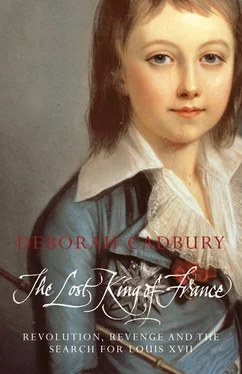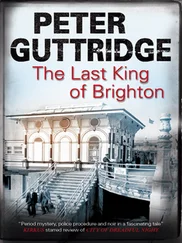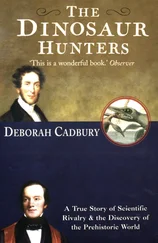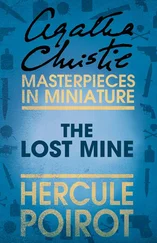HERE LIES LOUIS XVII.
CHARLES LOUIS, DUKE OF NORMANDY,
KING OF FRANCE AND NAVARRE.
BORN AT VERSAILLES ON MARCH 27th 1785.
DIED AT DELFT ON AUGUST 10th 1845.
There were now three graves for Louis-Charles – two in France and one in Holland – and more were to follow. Several claimants even created their own dynasties; to this day, Naundorff’s descendants resolutely seek to prove that he was the rightful king of France.
There is one remaining clue to the mysterious life of the young prince – a grisly relic inside the great gothic basilica at Saint Denis, in a northerly suburb of Paris. By the high altar, almost hidden by the tall pillars, there is a dark passageway leading down to an even darker underground world: ‘the City of the Dead’. Stretching almost the entire length of the basilica is the vast crypt, with vaulted ceiling and thick shadowy arches where by tradition the kings and queens of France now rest. At the bottom of the dark passageway, barred from the main crypt by a heavy iron grille bearing the Bourbon coat of arms, there is a side chapel known as La Chapelle des Princes. Unlit, except for an ornamental brass ceiling light which casts strange, spiky shapes across the deep shadows of the room, the chapel is crammed with wooden coffins.
Beyond these coffins, thin shafts of light direct the eye to a crucifix and stone shelving behind, displaying various brass caskets. These contain the preserved organs, hearts and entrails of various Bourbon kings of France, removed, according to tradition, prior to embalming the bodies. Hard to discern in the dim light, on the bottom shelf behind the crucifix there is a small, plain, crystal urn, marked with the Bourbon fleur de lys. It contains a round object that, on first inspection, resembles a stone, shrivelled and dried hard as rock, hanging on a thread. Yet this is no ordinary stone. This is thought to be the actual heart of the ill-fated boy who died in the Temple prison, stolen from his dead body at the height of the revolution.
Now over two hundred years old, this child’s heart has had a remarkable journey through time. Cut hurriedly from the supposed Dauphin’s body during his autopsy in the Temple prison in 1795 and smuggled out in a handkerchief, the heart which once raced and quickened to the Terror of the revolution even in death became a symbol to be treasured or despised. Preserved merely to be stolen once more, hidden in grand palaces and lost again during the revolution of 1830, only with the passage of time, as the years slowly buried all painful memories, was the child’s heart quietly forgotten, eventually coming to rest by the coffins in La Chapelle des Princes.
With recent developments in forensic science it has become possible to uncover one of the most enduring secrets of the French revolution – what actually happened to the Dauphin – and for his true identity to be revealed. With improvements in the restoration of ancient DNA and the analysis of special genes inherited from the maternal line, known as mitochondrial DNA, the petrified heart of the child offers a possible end to two hundred years of speculation.
The fate of the royal family during the revolution was still a sensitive issue in France. Some maintained that modern science was making an unwelcome intrusion into the past and might reveal secrets best forgotten. However, the Duc de Bauffremont, head of the Memorial of France at Saint Denis, an organisation that superintends the royal graves, gave his consent. ‘There are so many hypotheses about what happened,’ the Duke told reporters. ‘Now, maybe, we will know what happened once and for all.’
On 15 December 1999, at the abbey of Saint Denis, the crystal urn which held the heart was veiled in a purple cloth and brought out from its shadowy tomb in La Chapelle des Princes for scientific testing. A small crowd had gathered in the basilica: leading scientists such as the geneticist Professor Jean-Jacques Cassiman from the University of Leuven, Belgium, historians with an interest in the case, notaries to witness the proceedings, the inevitable TV crews and the various Naundorff and Bourbon pretenders to the French throne. The heart was placed on a small table in front of the high altar. Here, bathed in a fine tracery of stained-glass light, it could be clearly seen: an unprepossessing object, not unlike a garden stone. It was blessed by the priest who led a short ceremony. ‘I do not know whose heart this is,’ he said, ‘but it is certainly symbolic of children anywhere in the world who have suffered. This represents the suffering of all little children caught up in war and revolution.’
With great solemnity, the crystal urn was taken in a hearse to the nearby Thierry Coté Medical Analysis Laboratory in Paris. Here, with every step of the proceedings scrutinised by law officers who were masked, gowned and standing well back, it was placed on a bench and carefully examined. In spite of its eventful passage through history, Professor Cassiman could see at once that the organ was remarkably well preserved; its vessels and compartments were still intact. Could this really hold the secret to the identity of a small boy who was meant to inherit the most prestigious throne in Europe? Looking at the heart, he was immediately struck by something else as well. ‘The way the large blood vessel, the aorta, had been cut – this was not fine work, in fact it was really crude,’ he said. ‘This suggests that the heart had been removed from his body hurriedly. It’s not evidence – but it supports the history of the heart.’ Pathologists examined the heart and the development of the blood vessels to ascertain the age of the child. They estimated the child was eight to twelve years old, ‘which again fits nicely with the age of Louis XVII’, adds Cassiman.
The two-hundred-year-old heart was hard as rock. Anticipating this, Cassiman and his colleague, Dr Els Jehaes, had brought a sterile handsaw with which they could cut along the bottom tip. It took some time to saw a small strip, barely a centimetre wide; this was then split in two. ‘One sample we put in a sterile tube for us to test in Belgium,’ says Cassiman. ‘The other was for a leading genetics laboratory in Germany which we had invited to carry out tests independently.’ Both tubes were sealed and escorted to the respective laboratories.
Invisible to the naked eye for over two centuries, the secrets locked within the tissues of this heart could now be revealed to modern science. Did the young son of Louis XVI and Marie-Antoinette die a brutal death during the French revolution? Or did he escape this fate and survive, only to be ridiculed later as an impostor when he returned to claim the throne of France? In the gloved hands of the geneticists, the centuries of time which had slowly buried the terrible story of the owner of the heart could now be rolled back to solve one of the great enigmas in the history of the revolution. For the first time, the true story of Louis XVI and Marie-Antoinette’s son and heir can be told and his memory can finally be laid to rest.
PART ONE
1 ‘THE FINEST KINGDOM IN EUROPE’
Man was born free, and everywhere he is in chains.
Jean Jacques Rousseau, Social Contract (1762)
On Saturday 21 April 1770, Archduchess Maria-Antonia of Austria left her home, the imperial palace of Hofburg in Vienna, for ever and embarked on the long journey to France. On departure, in the courtyard in front of the palace, the royal entourage assembled. Two grand berlines lavishly upholstered in blue and crimson velvet and decorated with fine embroidery had been provided by the French ambassador to take Maria-Antonia to Paris. These were to be conveyed in a cavalcade of almost fifty carriages, each to be drawn by six horses and an array of guards and outriders. The whole of the Austrian court, in all its silken and bejewelled finery, attended this auspicious event. Maria-Antonia, the youngest daughter of the distinguished Empress Maria-Theresa and Emperor Franz I, was to marry the future king of France and, it was hoped, consolidate Austria’s troubled relationship with France.
Читать дальше












